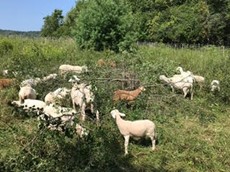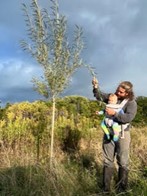 As producers we cannot control the weather, but we can build resilience into our farm systems to mediate its effects. Silvopasture – the intentional integration of trees and grazing livestock – has been a hot topic of agricultural webinars because growing trees can do just that. Alex Caskey combines his education in conservation biology with his love of lamb chops. His Katahdin sheep graze the trees along with the pasture grasses and then chew their cud under the shade of those same trees.
As producers we cannot control the weather, but we can build resilience into our farm systems to mediate its effects. Silvopasture – the intentional integration of trees and grazing livestock – has been a hot topic of agricultural webinars because growing trees can do just that. Alex Caskey combines his education in conservation biology with his love of lamb chops. His Katahdin sheep graze the trees along with the pasture grasses and then chew their cud under the shade of those same trees.
“Rotational grazing is foundational to silvopasture since trees cannot thrive under continuous livestock pressure. I approach it as advanced rotational grazing because you must account for the wellbeing of the trees in addition to the animals and pasture resource,” says Alex Caskey. It takes some planning and knowledge, but it is great for producing healthy sheep while simultaneously improving farm resilience.
Alex runs Barred Owl Brook Farm in the Adirondacks of northern New York State. He and his wife, Audrey Crocker, bought a fallow 60-acre farm five years ago. Around that time, Alex attended Steve Gabriel’s on-farm workshop about his experience with silvopasture and Alex was hooked.
Alex had tagged and genotyped pronghorn antelope for a research project in Wyoming in his conservation work. He felt an inherent connection to Katahdin producers, who did the same work with domestic sheep in NSIP on their own farms. So far, culling decisions have been obvious. This is his first year enrolled in NSIP and he looks forward to collecting more data and using that to make informed decisions.
 Alex says, “Most people think of thinning existing forest as silvopasture, rather than planting trees and shrubs into existing pasture, but both approaches have merit. If pursuing the latter, starting on the edge of the field might be most manageable in order to allow for continued machinery access and changing workflow as you learn and figure out what works best for you.” Alex sees planting trees as an enhancement to use when it makes sense. One of the things he emphasizes is that adding trees to a grazing system doesn’t necessitate making wholesale changes to your management approach.
Alex says, “Most people think of thinning existing forest as silvopasture, rather than planting trees and shrubs into existing pasture, but both approaches have merit. If pursuing the latter, starting on the edge of the field might be most manageable in order to allow for continued machinery access and changing workflow as you learn and figure out what works best for you.” Alex sees planting trees as an enhancement to use when it makes sense. One of the things he emphasizes is that adding trees to a grazing system doesn’t necessitate making wholesale changes to your management approach.
By adding trees gradually over time, you can enjoy some of the many benefits they provide without major disruptions to farm operations. Certain trees work especially well for fodder and shade for ruminants. Here are a few of his favorites:
- Mulberry trees are very palatable and adaptable to the eastern US. Their berries attract many kinds of wildlife and the leaves are a protein source (~20-25% crude protein on a DM basis).
- Black locust trees create dappled shade, which keep pastures growing all season. They grow easily with lots of new shoots and their flowers produce nectar for honey bees. Its leaves are comparable nutritionally to alfalfa. Black locust wood is dense and extremely rot resistant, which makes for great fence posts.
- Honey locust trees also cast dappled shade and produce nutritious pods that are high in carbs and protein. Though sugar content varies considerably from one tree to the next, some pods contain up to 38% sugar. Unlike cattle, sheep are also able to digest the protein rich seeds (~25% crude protein on DM basis) meaning that honey locust pods are nutritionally comparable to oats and barley. Their tendency to stay on the tree well into winter adds to their value as a supplemental feed source. In terms of palatability, some people report that it takes some training to get sheep to consume the pods, but they will readily consume them once trained.
- Willows are used extensively for livestock feed in many parts of the world where they are valued for their medicinal qualities. They are high in condensed tannins which act as a natural dewormer when consumed by livestock. They also contain anti-inflammatory and pain-relieving compounds, such as salicylic acid, the active ingredient in aspirin.
Besides requesting lamb for his birthday each year, Alex felt that ruminants just made sense on this new farm. They could start with less fencing and infrastructure and build as they learned. Electric netting is solely used on his land for fencing with solar chargers. The constantly  changing fence line has helped Alex to change and alter paddocks as their production grows. He rotates every 4-5 days with 5-6 rolls of electric netting each time.
changing fence line has helped Alex to change and alter paddocks as their production grows. He rotates every 4-5 days with 5-6 rolls of electric netting each time.
Last year, they bred about 19 ewes to two rams. Those rams were purchased from the first EAPK auction. Alex was impressed, as he could plainly see the higher production that those rams contributed to his operation. He utilizes a high tunnel in winter for feeding hay to the sheep. Then, lambs are born in early May to utilize the rapid spring growth.
Alex feels that, “With regard to the species of trees used in a silvopasture, the focus is often on timber, fruit and nuts for human consumption. These trees tend to offer a higher ceiling in terms of return on investment in the long term. However, they are accompanied with higher production costs and often require more intensive management.” Trees as a feed source for animals have been less studied in agriculture and offer a lower barrier to entry – the low-hanging fruit, so to speak. Alex sees this area as a place with much possibility for exploration and research. He asks questions like:
- Which willows are most palatable for sheep and other grazing animals?
- Can honey locust pods (which contain sugar and protein) be ground and pelletized for animal feed? What is the potential for mulberry leaves and honey locust pods to be ground and pelletized for animal feed?
- How does the nutrition of leaves change throughout the growing season?
- What is the ideal rotation interval and seasonal timing for leaf fodder consumption by sheep?
Alex knows inherently that, “There are more questions, than answers.” In this way, he feels that he is in the right place. He enjoys the adventure of new learning and experimentation, and also sees it as a business opportunity. At Barred Owl Brook Farm, they are growing several species of fodder trees and shrubs, in order to evaluate them. Alex can compare their growth to determine which varieties do best in the northeast region. As well, he can watch for the nuances in how the sheep graze those trees to determine which they prefer.
“Any animal would benefit from silvopasture.” says Alex. One might assume that every sheep would graze different trees the same. Yet, we know as producers that different sheep could prefer different grasses, which would help them to thrive in our own production system. Alex selects animals in his system which thrive on fodder, as well as grass. He would like to develop Katahdin genetics on his farm which are proven to succeed in that mixed system through NSIP.
 In addition to the sheep operation, Alex runs a small tree nursery where other producers can buy trees for growing their own silvopasture. He sells bare root trees, which are sold as small saplings dug while dormant and shipped without soil. They can be shipped throughout the country.
In addition to the sheep operation, Alex runs a small tree nursery where other producers can buy trees for growing their own silvopasture. He sells bare root trees, which are sold as small saplings dug while dormant and shipped without soil. They can be shipped throughout the country.
Alex likes to give his sheep a buffet of food options. Right now, he estimates that 1% of his flocks’ food comes from trees. However, he hopes that as his young trees mature, their intake will rise to 10-20%. Tree fodder is a supplemental feed. However, drought and extreme weather conditions have affected most farmers over the years. If we can build plant diversity on our farms, that could help increase resilience to any future weather fluctuations. In this way, Alex has an eye to the future. At Barred Owl Brook Farm, they are experimenting with their own sheep on silvopasture, as well as growing trees for other farms who want to explore it too.
By: Beckie Hotz, EAPK Communications Committee
![]()


